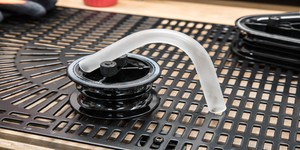
Da Loop
So, you are a little better armed than when you began - you know your parts, you know how they're measured so you don't end up with the wrong ones, and you understand the basic concepts at work inside of your system. Time to go out and buy stuff, right?Well, sort of. Before you go anywhere, you should probably think of how you'll put it all together. See, there's a funny little catch to all of this - though it seems like the traditional model of Pump -> Block -> Rad -> Res is that way for a reason, it actually has little effect.
Despite one part of your loop getting what seems to be slightly preferential cooling treatment (right after the radiator), the overall water temperature won't change much at all. Why? Well, a closed system will always reach a state of equilibrium. The cooling from the radiator will draw heat from the entire system by convection and conduction, as well as other topics that are well above the scope of this guide. Suffice it to say that though your CPU might get a half a degree cooler by putting it directly after your radiator - but if it's even that much, I'd be surprised.
The same is also true of pressure, so don't think you're doing yourself a favour by sticking that northbridge block at the end. Wherever the most restrictive rate of flow is for your system will always be the flow for the whole system - the whole system must be equal. And though there are points where pressure is more (right before a block opening, for example), for the most part it will distribute itself evenly again right afterwards.
So, if it doesn't have much effect, that means...build it how you like! If the best layout for you moves things around a little, don't be afraid to try it. Odds are, you won't kill your temps but you will have a cleaner-looking case.
With that said, you may now hit that order button and build your first loop. I'd recommend making it simple at first - maybe just the CPU, a pump, 120mm radiator and T-line to fill it (thus eliminating the need for a reservoir). But hey, you've got the basic ideas. It's worth noting that you'll usually cool a CPU and GPU better on two different, smaller loops than on one big one, but this is your setup - build it how you like it.
Just do me a favour, and remember to leak test your build for AT LEAST 24 hours before you secure it to your hardware. Don't say I didn't warn you...
Conclusion
So there you have it - a basic start to putting an end to those horrible, huge copper monstrosities that everyone calls a heatsink. Carefully drill in an LED, maybe add some UV reactive fluid or hose, and get rid of that ugly thing that weighs more than your little brother. All while enjoying the peace and quiet that only a well-built watercooling rig can have.I did want to take a few seconds at the end of this to thank some great people who have been instrumental in our upcoming water cooling content, of which this is just the beginning. For starters, a huge thanks to my Extreme Cooling forum posse of Nexxo, Coolmeister and Firehed. Each of these guys has been and continues to be a great help as we try to bring you the best coverage.
As well, we have a few corporate sponsors who you'll be seeing in our upcoming articles:

MSI MPG Velox 100R Chassis Review
October 14 2021 | 15:04















Want to comment? Please log in.